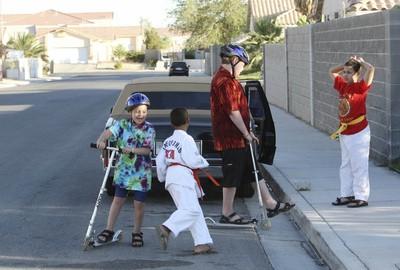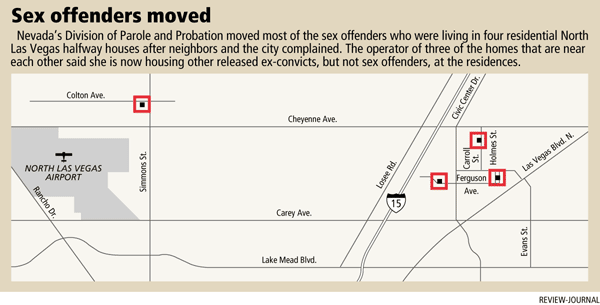Sex offenders move on, but families still wary


Children in a quiet North Las Vegas neighborhood near Cheyenne Avenue and Simmons Street have lately been dusting off their scooters and reclaiming their once abandoned cul-de-sacs.
Meanwhile, their parents are heaving collective sighs of relief.
Their former neighbors, the sex offenders, are gone.
“It’s such a joy watching the kids playing again,” said Zoe Hardge, the mother of two young boys. “The kids come over, chase each other, play baseball.”
Hardge and other parents in the community were keeping their children inside earlier this year after learning that a transitional home full of sex offenders was operating at 3009 Colton Ave.
They complained so loudly and persistently that Nevada’s Division of Parole and Probation agreed to move the sex offenders housed at the Colton facility and three other residential North Las Vegas halfway houses. The division also decided it would no longer allow released offenders to be housed in facilities that haven’t applied for state business licenses.
City officials, who claimed to have no idea that sex offenders were living in the homes, are now trying to make it more difficult for such halfway houses to operate without the city’s knowledge.
Hardge and other neighbors say they feel safer now.
But civil rights advocates and those who work with ex-convicts say forcing the sex offenders to move was unfair.
“People who are released from prison have to have someplace to go,” said Allen Lichtenstein, general counsel for the American Civil Liberties Union of Nevada. “The idea that we are going to run them out of town is not an acceptable solution.”
Marvie Hill and Eddie Wormwood, who operated the Colton house, did not return calls seeking comment. Both men said previously that they thought they were providing a valuable service by giving a home to sex offenders.
Penny Jackson, who runs three other North Las Vegas transitional homes that until recently housed a number of sex offenders, said the men should have been allowed to stay.
“I think it’s sad,” she said. “These are individuals that paid their debt and are being punished twice, through the penal system and again through the community.”
At least 20 men who had been living on Colton, at 1400 Ferguson Ave., 3025 Carroll St. or at 2712 Holmes St. had to move after neighbors and the city complained.
Men who were housed at the facilities had been imprisoned on a variety of charges, including statutory sexual seduction and sexual assault on a victim younger than 16.
Some of the men moved in with family members, said Capt. Kim Madris with Parole and Probation. Others were placed in a federally run halfway house in Las Vegas or moved into their own apartments in other areas of the Las Vegas Valley.
“For the most part, it was a very smooth transition despite the momentous challenge it was,” Madris said.
Jackson disagreed.
“I had one guy sleeping in my backyard,” she said. “He didn’t have any money and had no place to stay. I don’t know where he ended up.”
She said another elderly man, who used a wheelchair, simply disappeared.
“Who knows where some of them are right now?” she said. “Some of them made it. Others, they’re just out there.”
Officials did allow a small number of elderly sex offenders to remain at the Ferguson location.
“They are very ill offenders we were not able to place due to their medical needs,” Madris said. “Despite their crimes, they are still human beings. We still have to think about what is best for their needs.”
But North Las Vegas City Councilman William Robinson said he’s working to get the remaining men out.
“They have to go,” he said. “It’s not a total clean-up if they don’t get those (men) out, too. If you leave one, you’re setting a precedent for others.”
Assistant City Manager MaryAnn Ustick said the city is also working on an ordinance that would make it more difficult for group homes that house released sex offenders to fly under the city’s radar.
North Las Vegas last year placed a moratorium on new group homes because of concerns about allowing released offenders to live in them. The moratorium expired in November after the city put stricter guidelines into effect for the homes.
Still, “it’s been very difficult for us to determine which are group homes that house other types of clientele, such as people with disabilities, and which are those that are actually housing released offenders,” Ustick said. “We are looking at an ordinance that would address group care facilities … trying to address some aspects of the impact on neighborhoods.”
The new ordinance, still being drafted, is scheduled to go before the planning commission in July.
Lichtenstein said putting certain restrictions on where sex offenders may live, such as reasonable distances from schools, is acceptable.
“But wholesale saying, ‘We’ll decide who’s allowed to live here and who’s not,’ is not a way to run a local government,” he said. “It may be popular, but that does not mean it passes constitutional muster.”
Ustick said the city is carefully drafting its new ordinance to avoid running afoul of federal fair housing laws, which prohibit discrimination based on several factors, including disabilities.
Robinson said drafting of the ordinance must be handled delicately.
“It’s like walking on a gasoline ocean with a lit torch in your hand,” he said.
The city also hopes to close a loophole in its registration process for nonprofits, which officials say let certain halfway houses fall through the cracks.
The four transitional homes that were housing sex offenders were operated by nonprofit organizations, and as such were not required to obtain business licenses, city officials said.
Neighbors of the Colton Avenue facility were the first to discover they lived near such a transitional home when they received notice from the North Las Vegas Police Department that a Tier 3, or high-risk, sex offender had moved in.
“It goes to show you that whether you have an opinion or not, or want to get involved or not, things can really affect you,” said Gina Anderson, a neighbor of the Colton home. “Things can really be right on your block, right there with you and your families.”
Anderson commended the city’s response to neighbors’ complaints about the halfway houses.
But Mike Hubbard, who lives directly across the street from the Colton house with his wife and three children, said he didn’t think the city acted quickly enough and he doesn’t trust that all the sex offenders are really gone. He’s still being cautious about letting his kids play outside.
“At the moment, I’m not convinced that there’s not somebody living there” at the Colton house, he said. “I still don’t have any faith that they completed the project.”
Madris said the entire North Las Vegas episode served as a catalyst for the division to change how it places released offenders.
“If a transitional living or halfway house has not applied for a state license to be in business, we are no longer using them as an approved facility,” Madris said.
It can be difficult to find appropriate places for released sex offenders to live, she said, and new Nevada legislation that tightens restrictions on such offenders will make that process even harder.
Beginning later this year, Tier 3 sex offenders will not be allowed to live within 1,000 feet of schools, day care centers and other places that are designed primarily for children. They also will not be allowed to knowingly be within 500 feet of such places.
Tier 3 offenders also will be placed under GPS monitoring, which the offenders will be required to pay for if they’re able.
The ACLU has in the past criticized some distance restrictions, saying they could further alienate past offenders and make it more difficult for them to be rehabilitated.
Robinson said that was beside the point.
“I believe people should be rehabilitated,” he said. “But why should they be at the expense of jeopardizing the peace and tranquility of the residents in our neighborhoods?”
Jackson said she’s now housing other ex-convicts, not sex offenders, at the three North Las Vegas halfway houses east of Interstate 15. But she hopes to someday again offer homes to released sex offenders.
“I’m looking for a place far away from schools and parks where I can house them. They were my best residents.”












